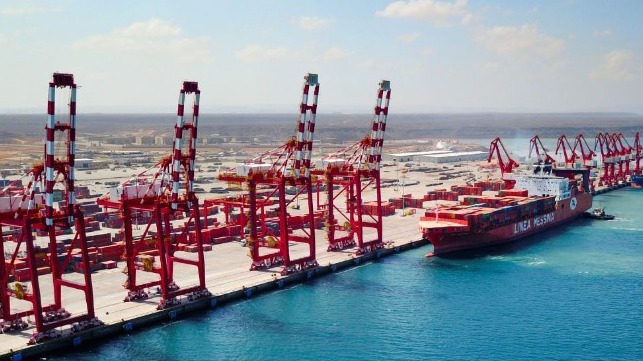New Pier at China's Djibouti Base Could Accommodate Carriers

China has completed construction of a pier large enough to hold an aircraft carrier at its Djibouti naval base, confirmed US Africom Commander Gen. Stephen Townsend at a recent appearance before the US House Armed Services Committee (HASC).
In October 2019, commercial satellite imagery emerged showing construction of a pier system at the naval base, leading to speculation that China is investing in a significant expansion of its presence at the entrance of the Red Sea.
The major construction work on the 340 meter pier appears to have been completed in January 2020, according to satellite data provided by open source intelligence analyst D-Atis. This is long enough to accommodate China’s new aircraft carriers and other large warships.
Recent satellite images of #China's support & logistics base in #Djibouti show how development work has carried on at the site through #Covid19 with new #PLAN modifications taking shape in the horn of #Africa https://t.co/mdGsDJDRY2 pic.twitter.com/2yFlpXFJBs
— d-atis?? (@detresfa_) May 9, 2020
Currently, China has two aircraft carriers: the Liaoning – a refurbished hull originally purchased from Ukraine - and the homegrown Shandong. A third carrier is under construction and will be unveiled within the next few years.
New article with beautiful new sat imagery of #China Navy Type-003 aircraft carrier.
— H I Sutton (@CovertShores) April 15, 2021
Estimate that it will be smaller than @USNavy Ford Class, but not by much. Overall in same league. https://t.co/vah1pnmFmp
“Their first overseas military base, their only one, is in Africa, and they have just expanded that by adding a significant pier that can even support their aircraft carriers in the future,” Townsend told HASC. “Around the continent they are looking for other basing opportunities.”

that matters most
Get the latest maritime news delivered to your inbox daily.
China’s Djibouti base was officially opened in 2017, and China ultimately plans to construct nine piers with four dedicated to the PLA Navy, according to India Today. The base was initially meant to support China’s anti-piracy missions in the Gulf of Aden, but it is steadily turning into a logistical supply hub for China’s warships.
The facility is also reportedly capable of accommodating the new Type 075 amphibious assault ship. The first in the class was commissioned last Friday by Chinese President Xi Jinping, and these vessels are at the core of China’s growing amphibious warfare capabilities.
